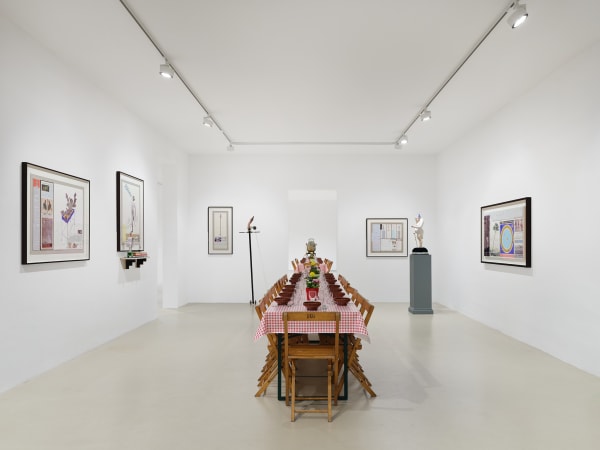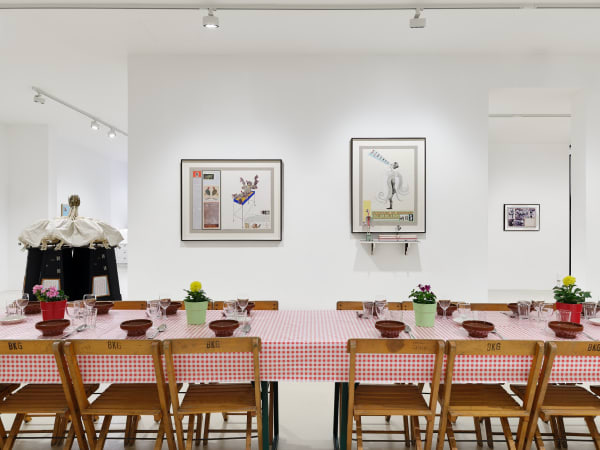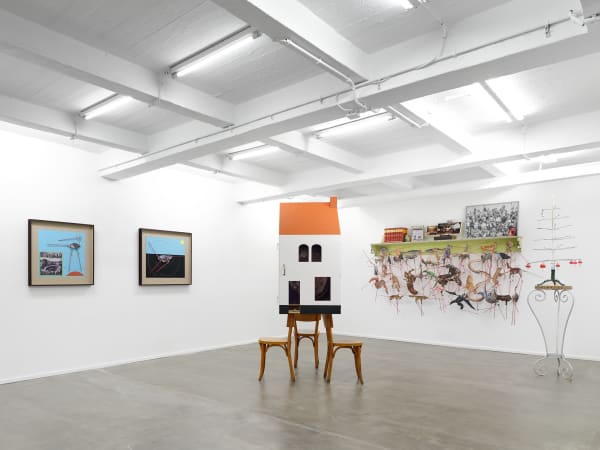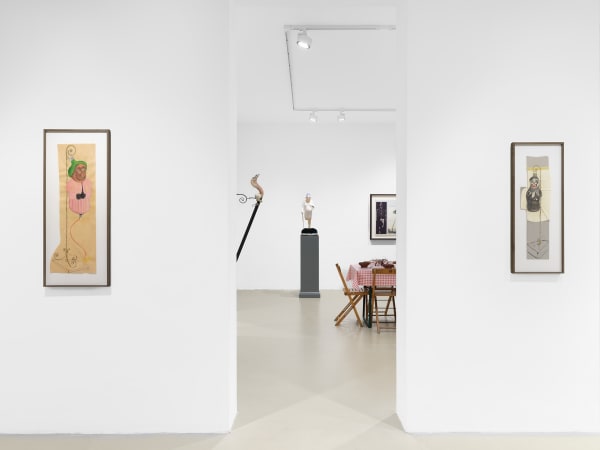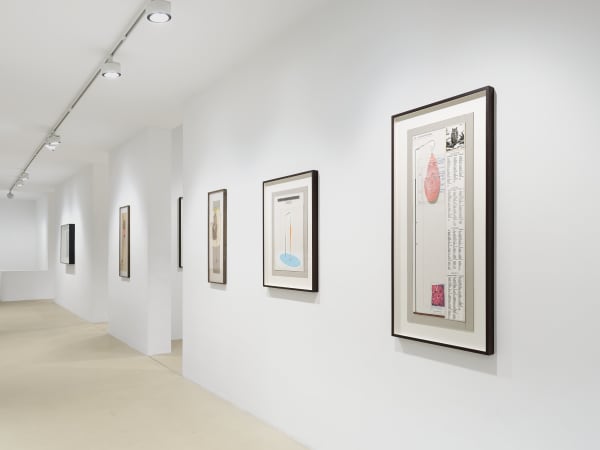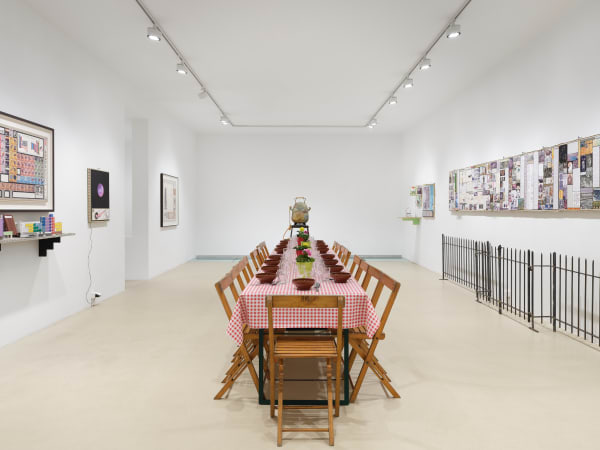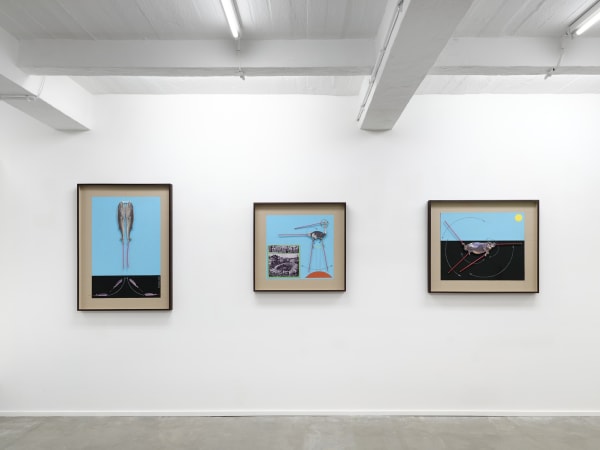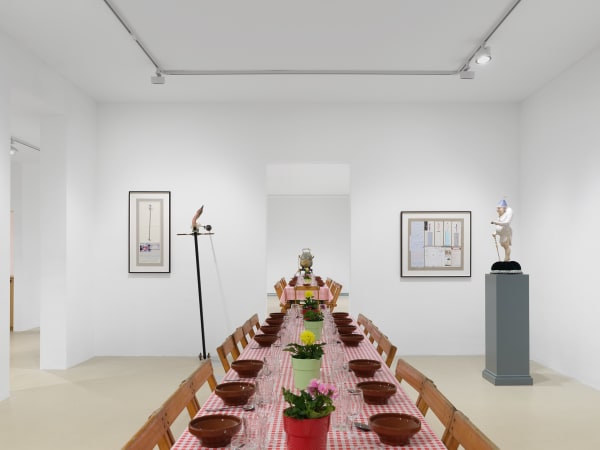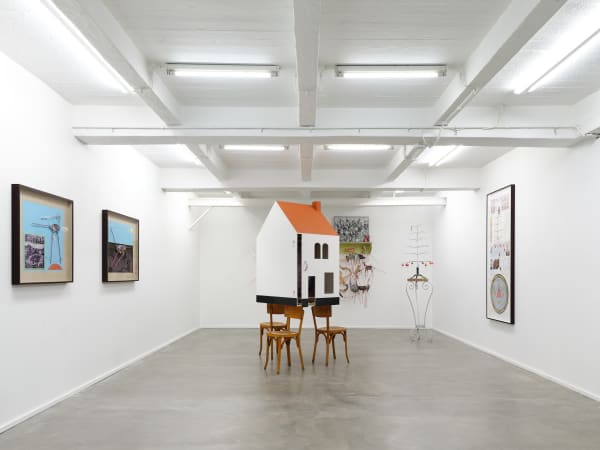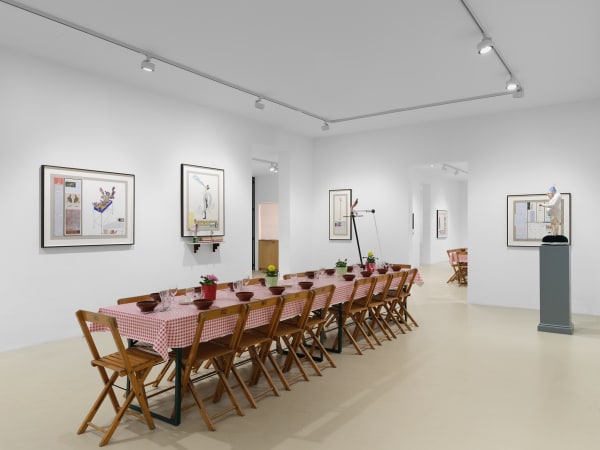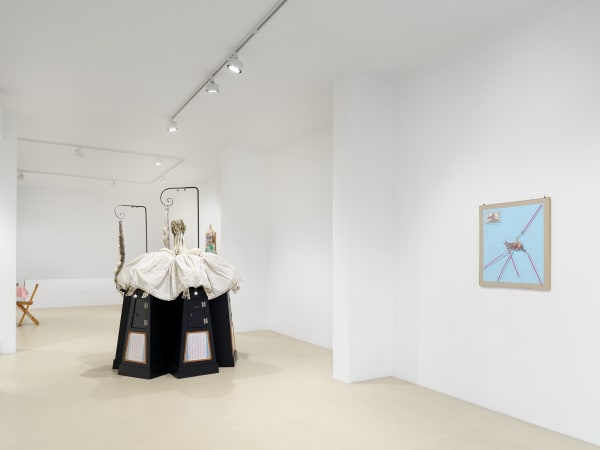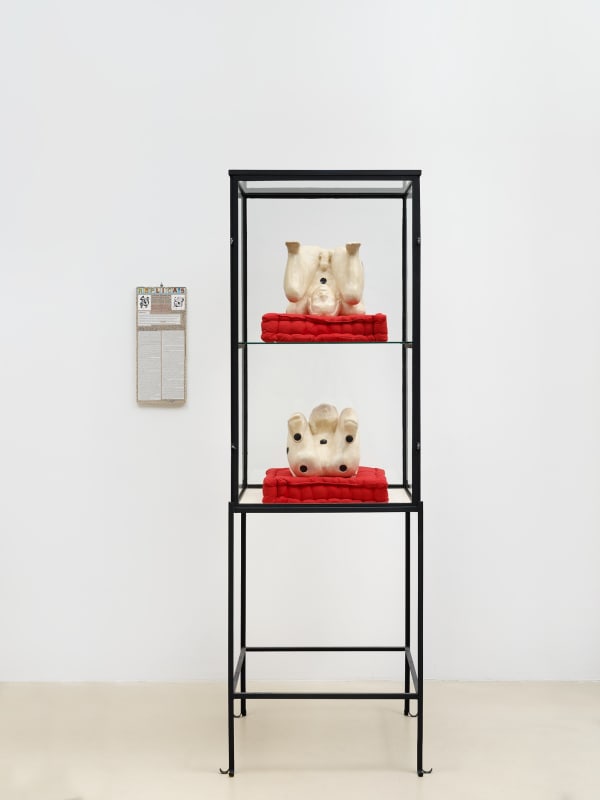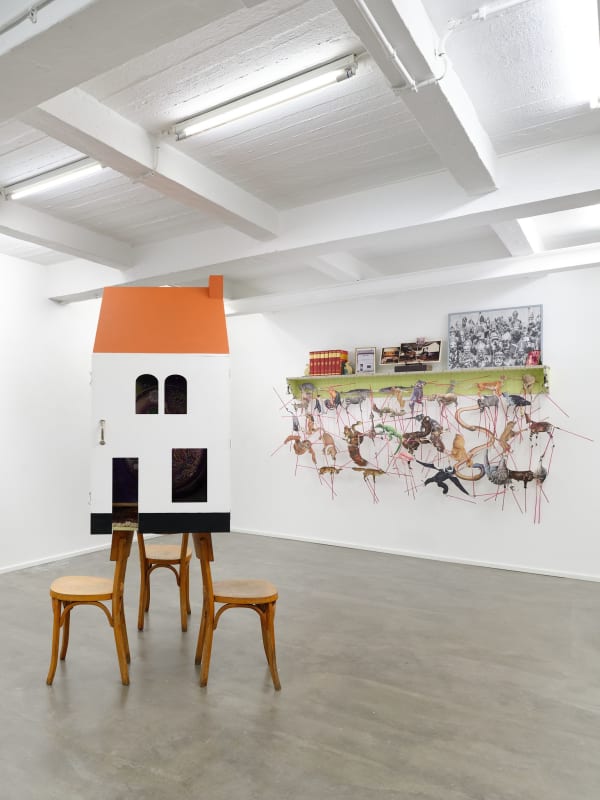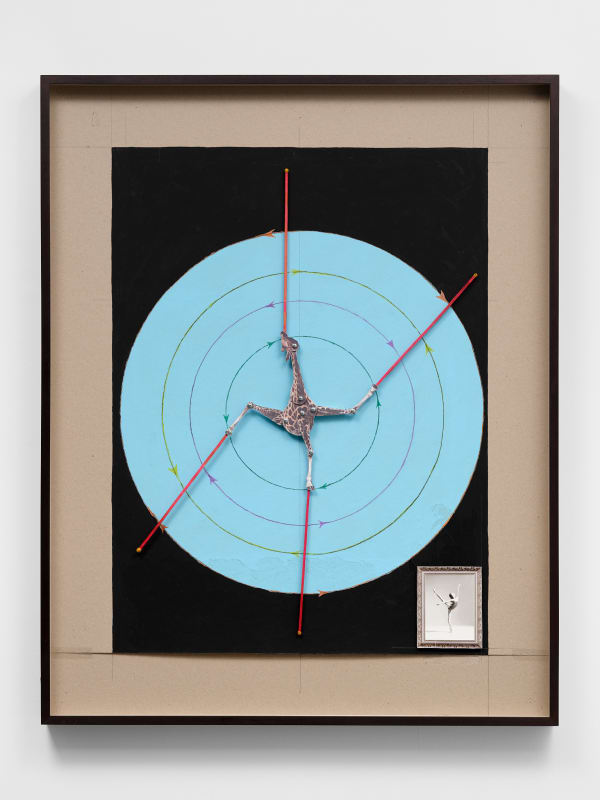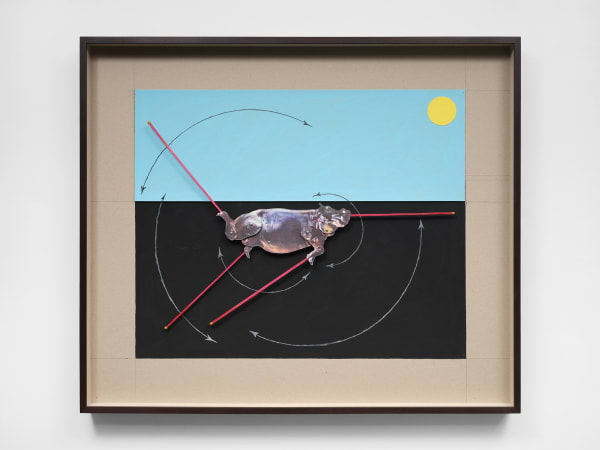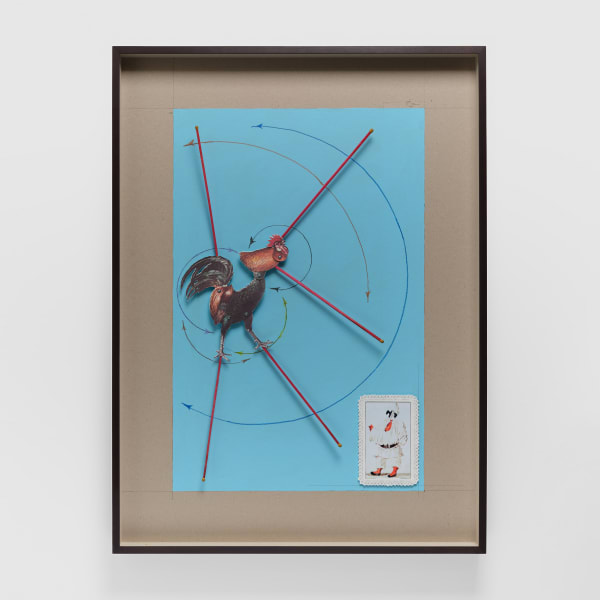Patrick Van Caeckenbergh: Vergeef mij dat ik u stoor...
Vergeef mij dat ik u stoor… delves into the fascinating world of Belgian artist Patrick Van Caeckenbergh. Passionate about classification methods, genealogies, and allegories, the artist revisits familiar themes and imagery in his first solo exhibition at Keteleer Gallery, seeking expansion and deepening. For over forty years, Van Caeckenbergh has been constructing an associative body of work in which one piece emerges from another, creating an interconnected whole where each element nourishes the next.
The artist is known for his elaborate and imaginative installations, collages, and sculptures. His work, characterized by meticulous craftsmanship and a playful creativity reminiscent of a child's imagination, simultaneously radiates a subtle mythical enchantment. It represents an ambitious and almost magical attempt to grasp human nature, with both scientific and popular references playing a central role. By using his own life as the foundation of his inquiry, he presents his practice not merely as an expression but as an essential, formative force of his personality. The personal elements in his work add an extra layer of meaning but, above all, highlight the impossibility of measuring things by anything other than his own history.
As an unmistakable prelude to the exhibition, Le Serpent Goulu, L’Indigestion Cosmogonique (2016–2024) points to human greed in contemporary society. The egg, as a primordial symbol of creation, and the snake, as a sign of eternal life, clash here with the impulse for overconsumption. The snakes hanging from a stake have been too greedy, generating a new cosmogony from their excess. In defiance of the current state of the world, the artist calls for modesty and humility.
That same warning resonates in Ultimate Survival (2025), the work that graces the cover of his new large-scale publication and whose text also inspires the title of this exhibition: "Frankenstein’s monster is both the ultimate outsider and the perfect world citizen; he is excluded everywhere, horrifying to look at, yet he is composed of all kinds of human material. As he, like a child, first learns about the nature of the world and himself, he becomes the archetypal lector virgo, the inquisitive being willing to read from a blank page—a visitor to the world, without prejudices or experiences to shape his reading process. Since the monster is a traveler for whom there are no borders, no nationalities, no spatial limitations—because he belongs nowhere—he must apologize. This nomad knows neither inside nor outside; his home is the threshold. When the monster, after much hesitation, finally enters the blind hermit's cell, he utters the following words, which I find incredibly moving: ‘Forgive me for disturbing you…’" This poignant quote not only symbolizes Frankenstein’s yearning for connection and his awareness of his status as an outsider, it also underscores the artist’s investigative stance: curious, questioning, and always open to shifting perspectives.
A key work, Un Bon Dieu (Oeuvres Complètes) (1996–2025), testifies to Van Caeckenbergh’s enduring fascination with the body, digestion, and food. A bronze cast of his torso serves as a cooking pot in which, during the opening, he prepares soup and convivially serves it to the audience. The artist invites the public to share the homemade soup, a metaphor for knowledge and a ‘mental meal.’ The set tables remain in place until the next soup is served, leaving remnants as a memory of the shared meal.
Van Caeckenbergh’s thought and creative process manifest in his designs and models, where he combines handwritten texts, drawings, old-fashioned fonts, and dictionary-style illustrations. These scale models function as a visual and formal laboratory, merging scientific curiosity with mythological and cultural references. His obsession with taxonomy, collecting, and the natural order of the world is evident in Unité d’Habitation (Ontwerp voor Résidence d’Etude) (1996–2024), where he links Le Corbusier’s housing model to his idiosyncratic interpretation of the periodic table or Mendeleev’s table. This reveals a fervent desire for order. Much like an illustrated encyclopedia, the work prompts reflection on alternative perspectives and unconventional systems of knowledge organization.
Works such as Un Autre Monde (2024) and Le Tombeau de Diderot (2023–2024) also reflect Van Caeckenbergh’s obsession with classification and encyclopedic knowledge. Inspired by the tree of knowledge from Diderot and d’Alembert’s Encyclopédie, Van Caeckenbergh recognized its resemblance to a prickly pear cactus and translated this into an anthropomorphic tomb monument for Diderot. His ingenious work explores the human urge to grasp the complexity of life in a layered manner. By exposing the gap between image, language, and the world, the artist unintentionally highlights the arbitrariness of any classification and categorization system, as well as the repeated and inevitably failed attempts to attain absolute knowledge of the world and life itself. Vergeef mij dat ik u stoor… invites the viewer to reflect on the human scale amid the intricate fabric of life.
Opening 10 May, 4 - 8 pm. In presence of the artist.
-
 Patrick Van Caeckenbergh, Les dieux suppliants (The Supplicant Gods), 2000 - 2004 - 2009 - 2014
Patrick Van Caeckenbergh, Les dieux suppliants (The Supplicant Gods), 2000 - 2004 - 2009 - 2014 -
 Patrick Van Caeckenbergh, Un Bon Dieu, 2025
Patrick Van Caeckenbergh, Un Bon Dieu, 2025 -
 Patrick Van Caeckenbergh, God Dobbelt Niet (God Does Not Play Dice), 2015 - 2025
Patrick Van Caeckenbergh, God Dobbelt Niet (God Does Not Play Dice), 2015 - 2025 -
 Patrick Van Caeckenbergh, Ma Bête Noir - Ontwerp voor "Mijn Stokpaardje", 2024
Patrick Van Caeckenbergh, Ma Bête Noir - Ontwerp voor "Mijn Stokpaardje", 2024
-
 Patrick Van Caeckenbergh, Het Leeghoofd - Ontwerp voor sculptuur, 1989-2024
Patrick Van Caeckenbergh, Het Leeghoofd - Ontwerp voor sculptuur, 1989-2024 -
 Patrick Van Caeckenbergh, De Eeuwige Terugkeer, 2025
Patrick Van Caeckenbergh, De Eeuwige Terugkeer, 2025 -
 Patrick Van Caeckenbergh, Gedachtenisse = Archive du Teatrino + La Ménagerie, 2018-2024
Patrick Van Caeckenbergh, Gedachtenisse = Archive du Teatrino + La Ménagerie, 2018-2024 -
 Patrick Van Caeckenbergh, La géneaologie du Sapin Noël, 2023-2024
Patrick Van Caeckenbergh, La géneaologie du Sapin Noël, 2023-2024
-
 Patrick Van Caeckenbergh, Teatrino - Mode d'Emploi, 2018-2024
Patrick Van Caeckenbergh, Teatrino - Mode d'Emploi, 2018-2024 -
 Patrick Van Caeckenbergh, La fête de St. Jean, 2023
Patrick Van Caeckenbergh, La fête de St. Jean, 2023 -
 Patrick Van Caeckenbergh, Ultimate Survival, 2025
Patrick Van Caeckenbergh, Ultimate Survival, 2025 -
 Patrick Van Caeckenbergh, Unité d'Habitation - Ontwerp voor Résidence d'Etude, 1996-2024
Patrick Van Caeckenbergh, Unité d'Habitation - Ontwerp voor Résidence d'Etude, 1996-2024
-
 Patrick Van Caeckenbergh, De Eeuwige Terugkeer, 2025
Patrick Van Caeckenbergh, De Eeuwige Terugkeer, 2025 -
 Patrick Van Caeckenbergh, Un Bon Dieu, 2025
Patrick Van Caeckenbergh, Un Bon Dieu, 2025 -
 Patrick Van Caeckenbergh, Le Tombeau de Diderot - Ontwerp voor sculptuur, 2023-204
Patrick Van Caeckenbergh, Le Tombeau de Diderot - Ontwerp voor sculptuur, 2023-204 -
 Patrick Van Caeckenbergh, Un Bon Dieu , 1996-2025
Patrick Van Caeckenbergh, Un Bon Dieu , 1996-2025
-
 Patrick Van Caeckenbergh, Un Autre Monde - Ontwerp + maquette voor Kazuifel - 4 jaargetijden, 2024
Patrick Van Caeckenbergh, Un Autre Monde - Ontwerp + maquette voor Kazuifel - 4 jaargetijden, 2024 -
 Patrick Van Caeckenbergh, De Grote Veldslagen, 2025
Patrick Van Caeckenbergh, De Grote Veldslagen, 2025 -
 Patrick Van Caeckenbergh, Le Saisonnier - Ontwerp voor sculptuur in boom (uil & tong), 1998-2024
Patrick Van Caeckenbergh, Le Saisonnier - Ontwerp voor sculptuur in boom (uil & tong), 1998-2024 -
 Patrick Van Caeckenbergh, Ontwerp voor Torso, 1999
Patrick Van Caeckenbergh, Ontwerp voor Torso, 1999

